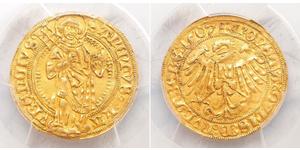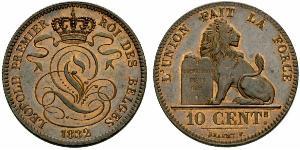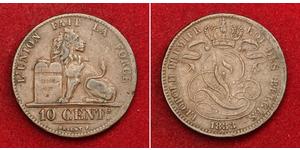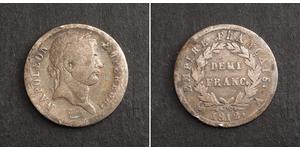(sold for $89.0)
Denomination: Gigliato Mint Period: 1396-1421 AD Mint Place: Rhodes (Island, Greece) State: Knights of St. John (Knights Hospitaller) Reference: Metcalf (Crusades) 1216, CCS 25d. R! Ruler: Juan Fernández de Heredia (Grand Master, 1377-1396) Condition: Pierced, lightly deformed and minor edge-damges, otherwise a VF+ Diameter: 30mm Weight: 3.67gm Material: Silver
Obverse: Grand Master kneeling left before patriarchal cross on three steps above sheaf. Castle in right field. Legend: + : H : IOh : FЄR(An)DI : D : G m OSPITLIS ("Brother Juan Fernandez, by the grace of God, Master")
Reverse: Cross fleurée. Each bar ending in shield with arms of the Order of Saint John. Legend: + OSPTAIS : IOhIS IRL nI 9T RODI ("Hospitaller of Saint John of Jerusalem and Rhodes")
The Knights Hospitaller, also known as the Hospitallers, Order of Hospitallers, Knights of St John, Order of St John, and currently The Sovereign Military and Hospitaller Order of St. John of Jerusalem, called of Rhodes, called of Malta, were among the most famous of the Western Christian military orders during the Middle Ages.The Hospitallers arose as a group of individuals associated with an Amalfitan hospital in the Muristan district of Jerusalem, which was dedicated to St John the Baptist and was founded around 1023 by Blessed Gerard to provide care for poor, sick or injured pilgrims to the Holy Land. Note that other sources claim the Amalfitan order and Amalfitan hospital were different from the order of Gerard Thom and their hospital. After the Western Christian conquest of Jerusalem in 1099 during the First Crusade, the organisation became a religious and military order under its own charter, and it was charged with the care and defence of the Holy Land. Following the conquest of the Holy Land by Islamic forces, the order operated from Rhodes, over which it was sovereign, and later from Malta where it administered a vassal state under the Spanish viceroy of Sicily.
The order was weakened by Napoleon's capture of Malta in 1798 and became dispersed throughout Europe. It regained strength during the early 19th century as it repurposed itself toward humanitarian and religious causes. In 1834 the order, by this time known as the Sovereign Military Order of Malta (SMOM), acquired new headquarters in Rome where it has remained since. Five contemporary, state-recognised chivalric orders which claim modern inheritance of the Hospitaller tradition all assert that the Roman Catholic SMOM is the original order, and that four non-Catholic orders stem from the same root: Protestant orders exist in Germany, the Netherlands and Sweden, and a non-denominational British revival is headquartered in the United Kingdom.
Juan Fernández de Heredia (in Aragonese Johan Ferrández d'Heredia, c. 1310 – 1396) was the Grand Master of the Knights Hospitaller from 24 September 1377 to his death. His tenure was occupied by the "affair of Achaea", the persistent, but ultimately fruitless, efforts by the Knights to acquire the Principality of Achaea in southern Greece. He was also a great patron of the translation and composition of historiographical works in the Aragonese language and a counsellor to two Kings of Aragon.
Heredia was born in Munebrega, Kingdom of Aragon. As a knight of the Hospitaller order (from 1328), Heredia was the commander of the castles of Villel, Aliaga, and Alfambra. He was originally patronised by Peter IV of Aragon and Pope Innocent VI. Through the aid of the latter, he was appointed to govern the grand priories of the kingdoms of Castile and León, and of the abbey of Saint-Gilles in southern France, the richest priory of the order. He supported Peter IV against the Union of Aragon and fought on his side in the successful Battle of Epila (1348).
In 1346, with the king of Aragon's support, he gained the castellany of Amposta (which was the priory of Aragon). Heredia made himself and his family (and illegitimate children) enormously wealthy at the expense of the order. His power and influence was greatly circumscribed by the Grand Master Raymond Berengar, but in 1371 he entered the favour of Pope Urban V and was elevated as the master's lieutenant in Western Europe.
In 1376, Heredia conducted the fleet bearing Pope Gregory XI back to Rome, presaging the end of the Avignon Papacy. The next year, on September 24, Gregory formally appointed Heredia grand master, following the death of Robert of Juilly on July 27. Heredia embarked from Naplesfor Romania late in 1377, arriving in Vonitsa in April 1378. Heredia immediately set about to take Arta but was captured by Ghin Boua Spata, lord of Aetolia and Acarnania, and sold to the Ottoman Turks. He was quickly ransomed, for he was in Glarentsa on 20 May 1379, though during his absence, his commandant, Gaucher of La Bastide, hired the Navarrese Company of mercenaries and brought them to the Principality of Achaea for eight months.
After his release, Heredia went to Rhodes, the headquarters of the order, in July. Power was readily ceded to him, as he was an adherent of the Avignonese Pope Clement VII. Heredia tried to make a deal to have the Navarrese turn over the castles they were holding in the name of the prince to the military order. The Navarrese' preponderant demands, however, quickly sunk any possible agreement. Heredia ignored the powerful company and instead dealt directly with Marie of Blois, who claimed the principality on behalf of her son Louis II of Naples. Marie signed over her son's rights to the order on 24 January 1387, with the consent of Clement VII. The transaction cost the order 20,000 gold florins. Later, the pope reversed his endorsement at the request of the Achaean claimant Amadeus, Lord of Pinerolo.
Despite these failures with the Navarrese, Heredia had continued to use them in his war. Though Peter IV had forbid any Hospitallers of his realm to travel with Heredia east, he himself had claimed the rights to the Duchy of Athens. The Navarrese, under Juan de Urtubia, attacked Thebes, the capital of the duchy, and Heredia, though friendly with the king, was warned in a letter to stop abetting his enemies (10 September 1380).
Heredia spent most of his life in Avignon after 9 April 1382, when he embarked for the West with his powers diminished some by the untrusting convent in Rhodes. In April 1383, the Roman Pope Urban VIappointed Riccardo Caracciolo, prior of Capua, anti-master in opposition to Heredia. Caracciolo had the support of some Italian priories, of the England and other Urbanist regions, but his power was insignificant by his death in 1395, after which no one was elected to replace him. Heredia did not long survive him and was succeeded by Philibert of Naillac.
Heredia was wealthy and learned, a patron of historiography and translation. It was he who ordered the Chronicle of Morea translated into Aragonese sometime before 1393, though it does not contain any mention of his term of service in the Morea. The medieval stonework of his fortified castles in Mora de Rubielos and Rubielos de Morahas been much studied in the last few years. He was buried in Caspe. His tomb was destroyed by anarchist soldiers during the Spanish Civil War (1936–1939), although some photographs remain.
Only 1$ shipping for each additional coin purchased!

|
Posted by:
anonymous 2019-05-01 |
10 Centime Belgium Copper Leopold I of Belgium (1790-1865)
group has 8 coins / 8 prices
⇑
1/2 Franc First French Empire (1804-1814) Silver Napoleon (1 ...
group has 15 coins / 14 prices
⇑

















-300-150-e24KbzbiOVkAAAFL68Sjlth6.jpg)






